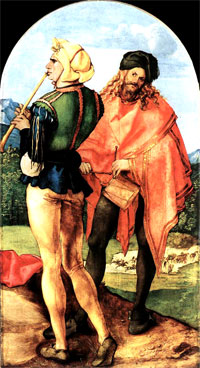The Minnesingers
The Minnesingers appeared in Germany soon after the rise of the Troubadours in France. We can consider them as belonging to a similar movement, maybe a parallel expression of the spirit of the time, as the direct connection between the two is disputable. Their name can be translated as love-singers, from the German minne, meaning love.
Their art was an expression of the medieval adoration of the Virgin as the ideal of womanhood, in a higher degree than in the case of the Troubadours, and an expression of the spirit of chivalry.
The craft of the Minnesingers appeared in the twelfth and thirteenth centuries, under the reign of the House of Hohenstaufen, amidst the turmoil of the Crusades, when the cathedrals of Strasbourg and Cologne were built. Their creation, the German Minnesong had its beginnings in the times of Frederick the Red. The strength of the movement is illustrated as early as 1207, when a song contest was held in the Wartburg fortress under the patronage of the Landgrave Hermann.

Two Musicians
by Albrecht Dürer
The Minnesingers movement developed mainly in southern Germany, in an area containing Swabia, Bavaria, Tyrol, and Upper Austria, whose base extends eastward from Strasbourg or Basle on the Upper Rhine to Vienna. Renowned centres were Freiburg in the west, Vienna in the east, and several other cities in Thuringia.
Minnesingers and Troubadours
The Minnesingers were of an entirely different character to that of the Troubadours. They were almost independent of the Provencal influence, although the western Minnesingers were often influenced by French models. But those in Austria or Bohemia were inspired by the popular songs of their regions.
One important difference is that the Minnesingers’ melodies had a feeling based more on the popular element, and less on the courtly love present in the songs of the Trouvères. They did not adopt the French conventional manner of expression, and elevated the art of poetry to a much higher standard than it had enjoyed under the Trouvères.
As a result, their compositions named Minnesongs also differ from those of Provence. They put more emphasis upon the beauty of nature, religious feelings, and abstract qualities of character.
The leaders and patrons of the Minnesingers were of noble ranks, and knights, princes, and kings studied the intricacies of rhythm or rhyme with the same energy they devoted to war. This was the reason why the art of the Minnesingers contributed to the growth of a special class of songs, belonging mainly to the nobility, and influenced the independent development of secular song.
They had a rare gift and thorough knowledge of their art. With perfect spontaneity they created poems with musical accompaniment subjected to strict rules in terms of number of strophes. The ability with which the Minnesinger utilized all possibilities of rhyme is perfectly amazing.
Influenced by German folk music, their songs were more austere than those of Provence, but marked by the same rhythm, phrase and tonality. Their compositions shaped melodies into the popular forms of the 16th century which led to the Protestant chorales.
The Minnesingers art relied upon the personality and depth of expression of the singer, rather than the tone of the song. As a result, Minnesongs cannot be always reproduced with the same effect as some of the Troubadours songs.
The Minnesingers were proud people. Out from a sense of dignity of their art, they avoided the help of jongleurs. They were their own interpreters and accompanists, and used the same classes of instruments as the Troubadours. However, the performance was focused mainly on poetry, with less interest for instrumental effects.
For this reason, the true Minnesong did not easily transform into forms of popular song. Its character and sophisticated associations kept it mainly in the hands of a limited, aristocratic class. Its direct influence upon music in general was less than in the case of the Troubadours, however it contributed to the early development of the Meistersinger movement, which belonged to the middle classes.
The Meistersingers
The name Meistersinger was given to those who attained the expert level of competence in verse and song. The Meistersingers were members of the burghers class, often of a humble artisan origin. Their prominence from the 14th to the 16th centuries corresponded to a period when the old order of feudal conditions was being replaced by manufactures and trades in organized towns.
The Meistersingers formed local societies, more or less secret and exclusive, similar to the guilds of other craftsmen in the commercial towns of Germany. These organizations were governed by elaborate rules. Membership was granted only after a period of initiation. The members were divided into classes, from the novices or scholars up to the recognized masters and were presided by several kinds of officers. Each guild had its hall, its insignia of membership, its special rules and traditional ceremony or procedure.
Some of their gatherings were for training (singing schools), others for rehearsal. There were also the formal competitions or trials of skill, where the position of judges was very important, since by their decisions they literally set standards.
The historic influence of the Meistersinger movement was considerable, affecting all Germany and spreading to neighboring countries. In many quarters it was supposed to represent a real form of art. In the later 15th century and afterward, some of its melodies were adopted as subjects for treatment by composers, and probably they exercised some influence upon the beginnings of popular religious songs of the Reformation.
Overall, the movement facilitated the dissemination of a certain technical knowledge among its adherents, however its creations lacked the outstanding spontaneity of the Minnesingers.
